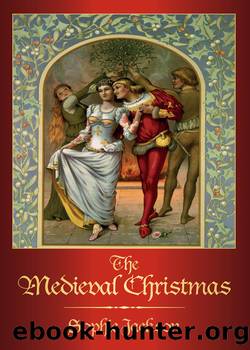The Medieval Christmas by Sophie Jackson

Author:Sophie Jackson
Language: eng
Format: epub
ISBN: 9780750956086
Publisher: The History Press
Published: 2013-09-24T00:00:00+00:00
Mistletoe
Mistletoe has ties to both Christian and pagan legend. It was considered a âheal-allâ by the Druids, whose great reverence for it came from the fact that the plant grew off the ground, never touching it. The plantâs magical properties were thought especially strong if it were found growing on an oak, which is a rare occurrence. The Druids believed that anything found growing on oak had immense healing powers and took great care when removing mistletoe from the tree, making a sacrificial offering of two white oxen before cutting the plant with a golden sickle and catching it in a cloth.
In Norse mythology, mistletoe was known as the plant that caused the death of the god Balder. His mother, Frigg, wept for her son, and her tears formed the pearly white berries of the mistletoe. She kissed everyone who passed beneath the tree where the plant grew and commanded that whenever people met beneath the mistletoe, they should do no harm to one another but kiss and go in peace. Some sources believe the custom of kissing beneath the mistletoe derives from this ancient legend and suggest that it arrived in England via the Viking invaders and became ingrained in medieval Christmas activities.
Like the other evergreens, mistletoe acquired a Christian meaning in the medieval period when a new urban legend began to circulate that the wood of the cross on which Christ was crucified actually came from the mistletoe rather than the holly, the belief being that in those distant days the mistletoe had actually been a tree. It was thought that after Christâs death, the mistletoe was so ashamed of being used for the cross that it shrunk from a tree into the small plant it is today and was denied any contact with the ground. This legend has links with the myth of the death of Balder, in which the mistletoe acts as his unintentional murderer, as well as ties with the Druidsâ belief that mistletoe lost its magic if it were allowed to touch the ground.
This attempt to Christianise the mistletoe had little effect on the church, the clergy forbidding use of the plant anywhere within their walls. One exception was York Minster, where every Christmas a large bunch of the evergreen plant was laid on the altar. This tradition is thought to be a throwback to the Roman Saturnalia but is a remarkable example of a pagan custom being adopted into the church â as we have seen, a frequent occurrence at the medieval Christmas.
For the ordinary medieval man and woman, there were many reasons why mistletoe should be so favoured as a Christmas plant, not the least of which was its role as a fertility symbol linked with the practice of kissing beneath it. In winter, the plant was fed to the cattle to keep them healthy and ensure fertility for the coming year; women also carried sprigs of mistletoe to help them get pregnant. It was thought an antidote to any poison, as
Download
This site does not store any files on its server. We only index and link to content provided by other sites. Please contact the content providers to delete copyright contents if any and email us, we'll remove relevant links or contents immediately.
The Switch by Beth O'Leary(1291)
Sisters by Daisy Johnson(1263)
The Enemy by Sarah Adams(1221)
Guard Duty by Sharon Dunn(997)
The Christmas Killer by Alex Pine(941)
The Chronicles of Narnia -Complete Series- by C. S. Lewis(892)
Explosive Situation by Terri Reed(873)
Alaskan Showdown by Sarah Varland(843)
The Ruthless Billionaire by Evangeline Kelly(801)
Dangerous Women by Hope Adams(780)
Fans Only by B. Love(754)
The Heart's Song by Winnie Griggs(720)
Valley of Shadows by Shirlee McCoy(706)
TRUTH by James Crow(691)
Truth of the Divine by Lindsay Ellis(691)
Nine by Rachelle Dekker(662)
World's End by Ed James(648)
Forget Me Not by Sarah M. Eden(587)
Kill Order by Adam Blumer(586)
